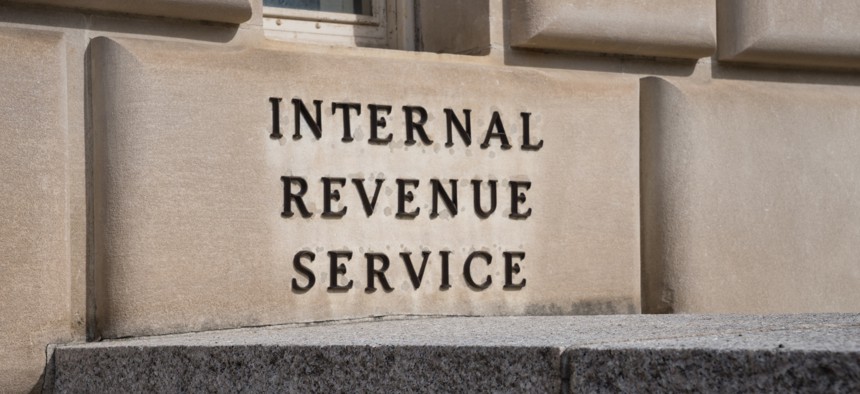
IRS officials said funding levels were extended through fiscal 2034, the agency could recover more than $800 billion in additional revenue. HABesen / Getty Images
IRS says its hiring surge and funding boost could generate $560B more than it thought
Improvements to IT, increased use of data analytics and deterrence factors will improve the return on IRS spending infusion, Biden administration says.
A funding and staffing surge at the Internal Revenue Service could lead to as much as $850 billion in new revenue over the next decade, according to a revised estimate by the Biden administration, which said its previous projections left out key drivers of improved tax collection.
Original estimates factored only the direct impact of hiring thousands of additional revenue agents within IRS, which Treasury Department officials now say neglected revenue-generating factors such as service improvements that make it easier for taxpayers to pay what they owe, boosted certainty for those with complex filings and efficiency gains by improving IT and data analytics. Using the old accounting system, IRS projected it would bring in $390 billion in revenue assuming elevated funding for the next 10 years.
Under the new accounting system, the Biden administration now projects it will take in $561 billion as a result of the tax, climate and health care bill known as the Inflation Reduction Act. That estimate assumed IRS funding levels would expire as scheduled at the end of fiscal 2031. If the funding were extended through fiscal 2034, as the administration has requested, revenue under the new estimate would jump to $851 billion.
“Previous IRS estimates were limited to revenues generated by direct enforcement activities resulting from higher enforcement staffing,” said Greg Leiserson, Treasury’s deputy assistant secretary for Tax Analysis. “This narrow focus does not consider the significant impact of the technology, data and service improvements made possible by the IRS, or any deterrent effect the greater enforcement capabilities and activities would have.”
Treasury did not account for Congress’ agreement to rescind $20 billion of IRS-directed IRA funds as part of the fiscal 2024 budget deal, which will mean the agency sees its boosted funding level expire some time in fiscal 2029 and—absent a reversal action—will never reach the new projection. Treasury officials said the $20 billion rescission would reduce revenues by more than $100 billion. Republicans have said they will continue to fight for additional cutbacks in future budget deals.
“This analysis demonstrates that President Biden’s investment in rebuilding the IRS will reduce the deficit by hundreds of billions of dollars by making the wealthy and big corporations pay the taxes they owe,” said White House National Economic Advisor Lael Brainard. “Congressional Republicans’ efforts to cut IRS funding show that they prioritize letting the wealthiest Americans and big corporations evade their taxes over cutting the deficit.”
Melanie Krause, IRS’ chief data and analytics officer, said IRA-funded improvements throughout the tax system would cause voluntary compliance to increase, also contributing to additional revenue generation. The estimate of annual uncollected taxes—known as the tax gap—grew to nearly $700 million in 2021. Technology improvements, including increased use of automation, and data analytics boosted by AI is enabling IRS to deploy both existing and new staff more effectively, which Treasury officials also cited for the revenue estimate increase.
“We cannot ignore the benefits of these improvements,” the department wrote in its new report.
The new projection factored only “specific deterrence,” referring to individuals who are audited and are then more likely to pay what they owe going forward, and not a more general deterrence that could result from increased voluntary compliance due to fears of enforcement spread through word of mouth.
Early efforts of increased enforcement have begun paying dividends, though on a much smaller scale. IRS last year announced a campaign to target 1,600 seriously delinquent millionaires, which has so far resulted in more than $500 million recovered tax payments.
The new estimates bring the administration closer to its original forecasts when President Biden first proposed injecting $80 billion into IRS accounts and said it would generate $700 billion in revenue. The Congressional Budget Office took a much more conservative approach, saying the funding would raise more than $200 billion in revenue, or a net of $124 billion.
IRS has already onboarded thousands of customer service personnel using IRA funds, resulting in a much improved phone answer rate last year and the opening of dozens of taxpayer assistance centers. The agency announced last fall it had 3,700 enforcement positions open. It is eventually expected to hire tens of thousands of employees over the life of its enhanced funding, though much of that will go toward backfilling longstanding vacancies and keeping pace with attrition. IRS now employs more than 90,000 people, its highest total in more than a decade.
Treasury officials cautioned if Congress does not take action to restore and continue higher levels of IRS funding, the agency would oversee rapid and drastic cuts to staff that would insufficient enforcement and taxpayer service.







